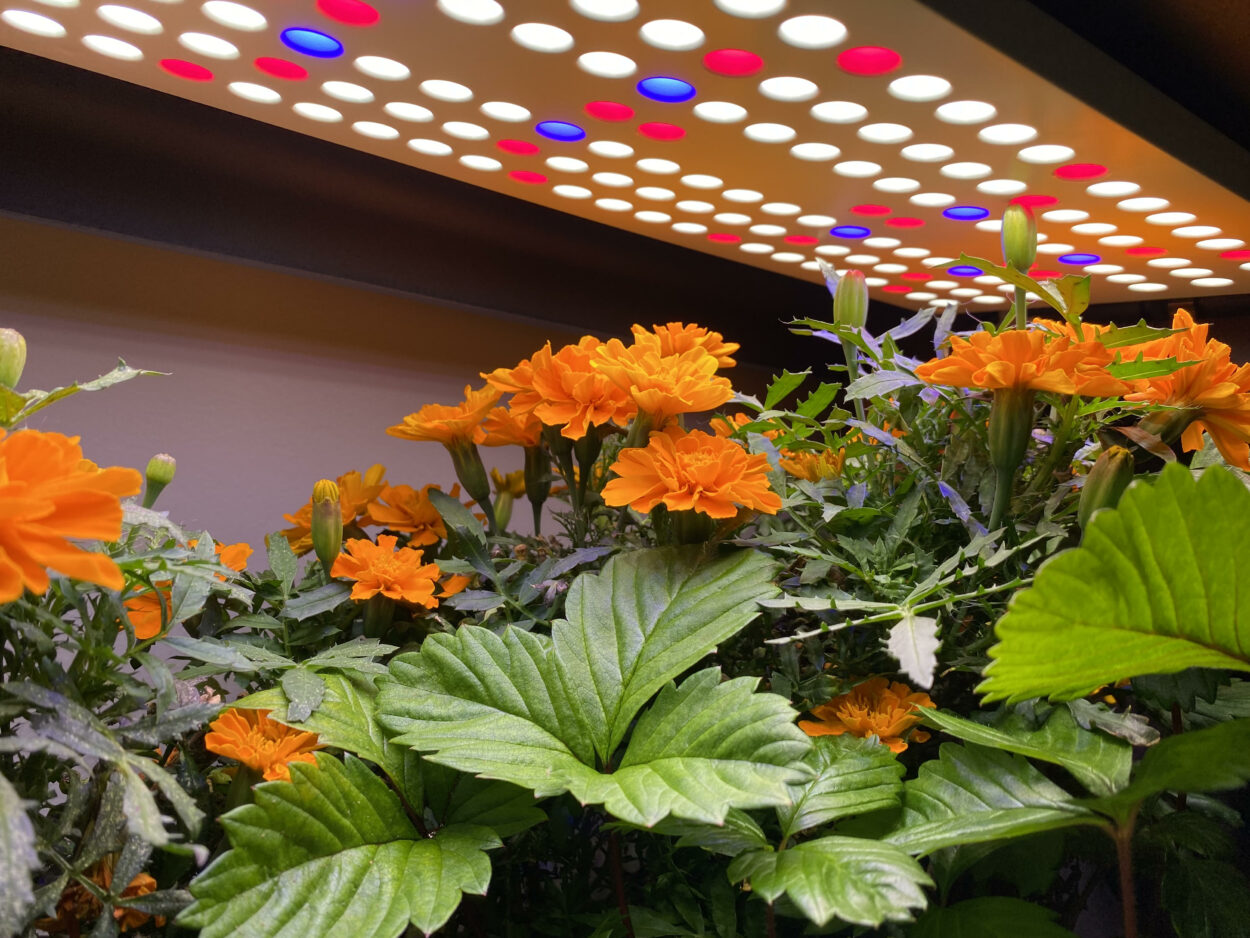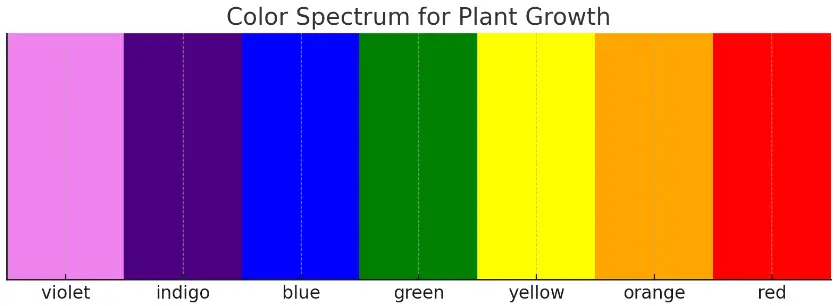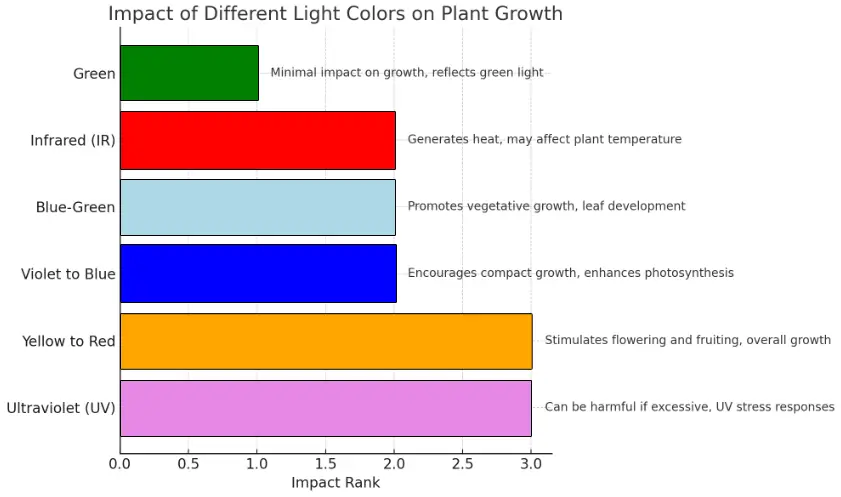Does Colored Grow Lights Make a Difference?

This post follows our research editorial guidelines.

As the bright days of summer fade into memory, it’s time to assess the light on offer to our indoor plants. You can counter this by supplementing natural lighting with a grow light – indeed, hydroponics enthusiasts often grow without any sunlight at all! Choosing the best grow light is the difference between a verdant indoor garden and a disappointing display.

What Type of Grow Light is Best for Growing Plants Indoors?
Most plants grow best with a cool, near-white grow light that outputs predominately blue and red light, with a touch of yellow. High-efficiency LED lights that target that spectrum are the most efficient.
This Guide Covers:
Understanding Grow Lights
Grow lights produce a sun-like light at the flick of a switch. Once placed near your indoor garden or hydroponic system, plants can use that light for photosynthesis, allowing them to grow as normal[1].
Growing up here in the Great White North, our days are short, and grow lights extend my options and growing season indoors. They also allow hydroponic gardens to thrive in the safety of a grow room, away from pests and the rigors of the weather.
Different Colors and How They Affect Plant Growth
| Wavelength (nm) | Intensity (Arbitrary Units) | Light Color | Impact on Plant Health |
| Below 400 | Very Low | Ultraviolet (UV) | Can be harmful if excessive, UV stress responses |
| 400 – 495 | High | Violet to Blue | Encourages compact growth, enhances photosynthesis |
| 495 – 570 | Medium | Blue-Green | Promotes vegetative growth, leaf development |
| 570 – 620 | Low | Green | Minimal impact on growth, reflects green light |
| 620 – 750 | High | Yellow to Red | Stimulates flowering and fruiting, overall growth |
| Above 750 | Very Low | Infrared (IR) | Generates heat, may affect plant temperature |
Factors to Consider when Choosing a Grow Light
When choosing your light, you’ll need to consider:
- Do you need the heavy support for a cropping plant or the lower needs of an ornamental?
- What area do you need to cover? A small fixture won’t suffice for a large hydroponic garden, and a big one is overkill for a single potted plant.
- Where is the light to be installed? Grow lights can be installed as hanging fixtures, and others will need floor space to stand.
- What is your budget? You’ll need to account for running costs as well as the initial purchase
What is a Color Spectrum?

The warm bright light of the sun is what is known as visible light – while it appears white to us, it contains all the colors of the spectrum, as well as forms of light that human beings can’t perceive[2].
The easiest way to understand this is to think of a rainbow. When white light from the sun passes through water in the atmosphere, it separates into all the different colors it contains. That wonderful variety of color is present in white light at all times, braided together in ways that make it hard to spot them.
When we talk about the spectrum of a grow light, we’re talking about what part of that rainbow the grow light emits the most. A blue-green light has more of the blue-green end of the rainbow, for example.
Cool and warm colors and their effects on growing plants
Bulbs also emit light that is either cool or warm. It’s typically measured as Kelvins and describes the precise balance of wavelengths that the light gives out.
For growers, it’s easiest to understand like this – a cool light produces more blue-green light, and a warm light produces more yellow-red. Cool lights promote vegetation, and warmer ones promote flowers and fruit.
Measuring the strength of grow lights
Grow light manufacturers typically list the intensity of their products somewhere in the description. Typically this is described in lumens, lux or footcandles. PAR and PPDF are also measurements you may find used to describe the strength of a light.
Lumens measure how bright a light shines[3]. Lux and footcandles are related – lux is the lumen strength over a square meter, whereas footcandles are the lumen strength over a square foot, instead[4]. These measurements are an indicator of how brightly the grow light will shine. It can help you ensure you have enough coverage for your rig[5].
PAR and PPDF are more precise. PAR stands for photosynthetically active radiation. It specifically describes how much of the light’s output is suitable for photosynthesis. PPDF stands for photosynthetic photon flux density. It’s a heavy-sounding term, but it really just measures the PAR over time.
Finally, a light will also generally list its wattage. Wattage is simply how much power a fixture uses. High wattage doesn’t always mean better light – poorly made bulbs can waste a lot of power. It’s best used to work out how much a light will cost to run.

Types of Grow Lights
- Incandescent grow lights are an older style of light that runs electricity through a filament. The filament converts the electricity to light and heat. They aren’t very energy efficient and they lack precision, producing a lot of waste heat and light that your plants can’t use. They are also increasingly rare – they’ve been fazed out in many parts of the world.
- Fluorescent lights produce light by running electricity through an inert gas. Small quantities of mercury inside the fixture become charged, causing a reaction that produces light. Like incandescent lights, their output is very broad and much is outside the range of what plants need to grow. While some plants will grow just fine under fluorescent lights, like golden pothos, most need more direct support.
- High-intensity discharge (HID) lamps are a powerful form of grow light. These include metal halide and high-pressure sodium lights. They function much the same as a fluorescent light bulb but are made to produce light at the right frequency for plant growth. These are serious lights, with intense output that can support huge areas. As a result, they are most commonly used in commercial setups and are generally too powerful for most home use.
- LED grow lights are ideal for most growers. Each bulb or bar is comprised of many small light-emitting diodes that produce a specific band of light. With the right mix of diodes, a single fixture can generate light that targets plant growth.
Advantages of LED Grow Lights
LED grow lights have quite a few advantages. They are cheap to buy and cheap to run, a critical benefit for home hydroponic gardeners.
They’re versatile and come in a range of different colors and intensities, so there’s something spot on for any type of plant, from the high demands of a hydroponics rig to the more relaxed requirements of ornamental plants.
LEDs are also longer lived than most lights, and create a smaller waste footprint. They contain fewer hazardous materials and can be recycled in many jurisdictions, making them even more environmentally friendly.
LED lights vs. Halogens
Halogen lights are a type of incandescent light that produces light via a complex reaction between the tungsten filament and halogen gas in the bulb. The reaction extends the life of the filament and produces a very intense level of light.
Halogens are sometimes suggested as a grow light. While they do produce more usable light than a standard incandescent bulb, they share all the same drawbacks. They run hot, guzzle power, and burn out far faster than an LED bulb. A high-efficiency LED grow light is always going to be a better option for the home grower.
Can You Use Any LED Lights to Grow Plants?
Not all LED lights are created equal. Many are optimized for energy efficiency, and so radiate as little light as possible. While you may enjoy the resulting low power bills, too little light is a death sentence for plant life.
Standard LED lights also do not always produce light in the right spectrum. The human eye tends to find warm colors less harsh, so many standard-use LED bulbs only emit the lower energy warm end of the spectrum. This isn’t the right balance of light to encourage foliage, leaves, or photosynthesis in general. It’s best to stick to purpose-designed grow lights.
The Effect of Light Color on Plant Growth
“Certain colors or wavelengths of light are more important for plant growth than others. Leaves reflect and derive little energy from the yellow and green wavelengths of the visible spectrum. In contrast, the red and blue wavelengths of the light spectrum are the most important energy sources for plants.” David H. Trinklein, Horticulture State Specialist, Division of Plant Sciences, University of Missouri
Does Light Color Affect Plant Growth?
Plants use a variety of different pigments to control their growth. Chlorophyll is the powerhouse and does most of the heavy lifting. There are two types of pigment – one that responds to red light, and another that responds to blue[6]. Those two colors of light are the most critical when it comes to plant growth.
But other pigments in the leaf are involved too. Carotenoids are orange pigments that give leaves their fall color[7]. They absorb yellow and orange bands, providing a source of indirect energy that is used to help regulate other aspects of plant growth.
Additionally, leaves contain chemical receptors that respond to different types of light. Phytochromes are tuned to red light and control the number and size of leaves a plant grows. Cryptochromes on the other hand respond to blue light and control the daily cycle of growth, as well as when to flower[8].

Best Color Spectrum for Different Stages of Plant Growth
Different types of light trigger different responses in plants. Much like sound, we measure light but its wavelength, is measured in nanometers. Low numbers indicate waves that are close together, carrying a lot of energy. High wavelengths are longer, with more spaces between the top of each wave. They have less energy.
Ultraviolet (below 400nm)
Ultraviolet (UV) light covers the lowest wavelengths of light and is most energetic. LED grow lights don’t emit UV, as it’s actively hazardous to plants and cause damage. It’s the same range that causes sunburn in people, too.
Violet to Blue (400-520nm)
Blue light is absorbed readily by leaf pigments. It’s high energy, so a little goes a long way – plants make good use of it for growth. It also triggers compact development, so too much blue light can cause plants to become stunted[9].
Green (570-620nm)
Usually neglected by most grow lights, green parts of the spectrum offer limited benefit to plants. Green light is reflected by plants, which is why they appear green.
Yellow (570-580nm)
Studies around the impact of yellow light on plant growth have demonstrated it plays an important part in plant physiology. It helps the plant regulate the growth generated by other wavelengths and promotes beneficial compounds inside the tissue. Studies have shown that plants grown with supplemental levels of yellow light produce more mass than those only grown in red and blue[10].
Red (620 to 750nm)
Red light is the other critical band. It helps support overall growth and promotes strong foliage. It’s so useful for plants that they can be sustained on almost entirely red light.
Ultraviolet
Infrared light is detected by living things as heat, rather than light. It can be useful to help keep greenhouses and grow rooms warm.
Choosing the Right Color Spectrum
Before you purchase your light, think about what you are growing. If you’ve focused on leafy greens like lettuces, herbs or the like, a light with a lot of blue to it will produce good results. Conversely, if you’re growing a fruiting crop like strawberries or tomatoes, aim for more yellow and red.
Indoor ornamental plants generally prefer lower energy but broader spectrum light, with a touch of green and yellow. This is especially true of ariods like alocasias, calatheas, and other plants that hail from forest understories. Even sun lovers like cacti and succulents do better with a broader spectrum of light that will promote all-round growth.
No matter what you are growing, you will need to ensure that both red and blue are present – sometimes called ‘burple’. This is the cornerstone of growth and is important to include.
Wrapping Up The Impact Of Colored Lights for Growing:
Low-power LED grow lights improve the success of my indoor garden. No matter what the weather or the aspect, my plants continue to exceed my expectations. Even in a dark northern-facing room or a windowless basement, there’s always room to thrive.
References:
- What is Photosynthesis? Smithsonian Science Education Center. Retrieved November 17, 2023, from https://ssec.si.edu/stemvisions-blog/what-photosynthesis.
- Electromagnetic Spectrum: Visible Light. NASA Science. Retrieved November 17, 2023, from https://science.nasa.gov/ems/09_visiblelight.
- Lumen (unit of energy measurement). Encyclopaedia Britannica. Retrieved November 17, 2023, from https://www.britannica.com/science/lumen-unit-of-energy-measurement.
- Definition of lumen. Oxford Reference. Retrieved November 17, 2023, from https://www.oxfordreference.com/display/10.1093/oi/authority.20110803100119644.
- Foot-candle. American Meteorological Society Glossary of Meteorology. Retrieved November 17, 2023, from https://glossary.ametsoc.org/wiki/Foot-candle.
- Causes of Color. WebExhibits. Retrieved November 17, 2023, from https://www.webexhibits.org/causesofcolor/7A.html.
- Pigments. University of California Museum of Paleontology. Retrieved November 17, 2023, from https://ucmp.berkeley.edu/glossary/gloss3/pigments.html.
- Phytochrome Signaling Mechanisms. National Center for Biotechnology Information. Retrieved November 17, 2023, from https://www.ncbi.nlm.nih.gov/pmc/articles/PMC3268501/.
- The effect of blue light on plants. Michigan State University Extension. Retrieved November 17, 2023, from https://www.canr.msu.edu/floriculture/uploads/files/blue-light.pdf.
- Effects of Yellow, Green, and Different Blue Spectra on Growth of Potato Plantlets In Vitro. Journal of the American Society for Horticultural Science. Retrieved November 17, 2023, from https://journals.ashs.org/hortsci/view/journals/hortsci/53/4/article-p541.xml?tab_body=fulltext.

Before you go!
How to Water Mint Plants – Avoid Over or Under Watering
5 Signs Your Snake Plant Needs Watering
How to revive an Air plant (Tillandsia): 7 Easy Steps
Are Air Plants Toxic to Cats?
Before you go!
What are the 8 types of hydroponics systems?
How to Get Rid of Algae in Hydroponics?
What is Electrical Conductivity in hydroponics – Why is EC Important?
The Secret To Growing Hydroponic Beans: A Complete Guide To Growing the Best Beans Indoors